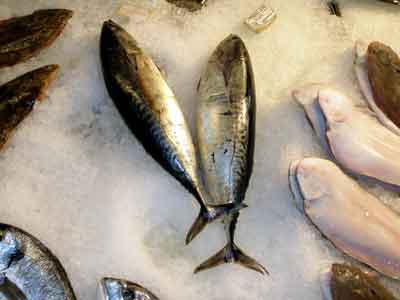
Cod, usually salted and dried but may also be fresh. A Basque speciality much eaten during Lent, it must be soaked for 24 hours or more before use, with occasional changes of water. It can often be purchased ready soaked on Fridays. Confusingly, restaurants often use this term to describe both fresh and salt cod.

Little tunny. The little tunny is a handsome fish with black scribble patterns on its back. It has a robust, torpedo-shaped body built for powerful swimming and it has no swim bladder. The mouth is large, the lower jaw slightly protruding past the upper jaw. The flesh of the little tuna is darker and stronger tasting than that of the other large tunas. It is marketed fresh, dried, canned, smoked, or frozen. It is often caught on hook and line near reefs.
Pollack. A member of the cod family found in the eastern and north Atlantic and weighing around 1 kg (2 lb). It is dark green above and has a protruding lower jaw. They have rather grey, flaky flesh and are often salted and dried or pickled and are also commonly used for making imitation shellfish foods. Treat is as you would cod. I have heard that Somerville and Ross, in the Irish RM, describe pollock as tasting like cotton-wool with pins in it.
Greater forkbeard. A greyish or brownish fish of the cod family with reddish fins, from Spanish waters. It is usually fried, but this must be done quickly as it does not keep well.
Three bearded rockling, onos. A small Mediterranean fish, the largest of which are prepared in the same way as whiting.